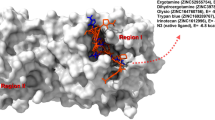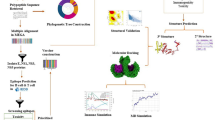Abstract
A high level of disorder in many viral proteins is a direct consequence of their small genomes, which makes interaction with multiple binding partners a necessity for infection and pathogenicity. A segment of the flaviviral capsid protein (C), also known as the molecular recognition feature (MoRF), undergoes a disorder-to-order transition upon binding to several protein partners. To understand their role in pathogenesis, MoRFs were identified and their occurrence across different flaviviral capsids were studied. Despite lack of sequence similarities, docking studies of Cs with the host proteins indicate conserved interactions involving MoRFs across members of phylogenetic subclades. Additionally, it was observed from the protein–protein networks that some MoRFs preferentially bind proteins that are involved in specialized functions such as ribosome biogenesis. The findings point to the importance of MoRFs in the flaviviral life cycle, with important consequences for disease progression and suppression of the host immune system. Potentially, they might have impacted the way flaviviruses evolved to infect varied hosts using multiple vectors.





Similar content being viewed by others
Data availability
The data that support the findings of this study are provided in the supplementary information.
References
Barik S 2020 Genus-specific pattern of intrinsically disordered central regions in the nucleocapsid protein of coronaviruses. Comput. Struct. Biotechnol. J. 18 1884–1890
Bateman A, Martin MJ, Orchard S, et al. 2021 UniProt: the universal protein knowledgebase in 2021. Nucleic Acids Res. 49 D480–D489
Berman HM 2000 The protein data bank. Nucleic Acids Res. 28 235–242
Byk LA and Gamarnik AV 2016 Properties and functions of the dengue virus capsid protein. Annu. Rev. Virol. 3 263–281
De Madrid AT and Porterfield JS 1974 The flaviviruses (group B arboviruses): a cross neutralization study. J. Gen. Virol. 23 91–96
Diner BA, Li T, Greco TM, et al. 2015 The functional interactome of PYHIN immune regulators reveals IFIX is a sensor of viral DNA. Mol. Syst. Biol. 11 787
Erdős G, Pajkos M and Dosztányi Z 2021 IUPred3: prediction of protein disorder enhanced with unambiguous experimental annotation and visualization of evolutionary conservation. Nucleic Acids Res. 49 W297–W303
Faustino, Martins, Karguth et al. 2019 Structural and functional properties of the capsid protein of dengue and related flavivirus. Int. J. Mol. Sci. 20 3870.
Goh GK-M, Dunker AK and Uversky VN 2015 Detection of links between Ebola nucleocapsid and virulence using disorder analysis. Mol. Biosyst. 11 2337–2344
Goh GK-M, Dunker AK and Uversky VN 2016 Correlating Flavivirus virulence and levels of intrinsic disorder in shell proteins: protective roles vs. immune evasion. Mol. Biosyst. 12 1881–1891
Goh G, Dunker A, Foster J, et al. 2019 Zika and flavivirus shell disorder: virulence and fetal morbidity. Biomolecules 9 710
Ishida T and Kinoshita K 2007 PrDOS: prediction of disordered protein regions from amino acid sequence. Nucleic Acids Res. 35
Ivanyi-Nagy R, Lavergne J-P, Gabus C, et al. 2008 RNA chaperoning and intrinsic disorder in the core proteins of Flaviviridae. Nucleic Acids Res. 36 712–725
Jones DT and Cozzetto D 2015 DISOPRED3: precise disordered region predictions with annotated protein-binding activity. Bioinformatics 31 857
Jumper J, Evans R, Pritzel A, et al. 2021 Highly accurate protein structure prediction with AlphaFold. Nature 596 583–589
Labeau A, Simon-Loriere E, Hafirassou M-L et al. 2020 A genome-wide CRISPR-Cas9 screen identifies the dolichol-phosphate mannose synthase complex as a host dependency factor for dengue virus infection. J. Virol. 94
Li M, Johnson JR, Truong B, et al. 2019 Identification of antiviral roles for the exon–junction complex and nonsense-mediated decay in flaviviral infection. Nat. Microbiol. 4 985–995
Malhis N, Jacobson M and Gsponer J 2016 MoRFchibi SYSTEM: software tools for the identification of MoRFs in protein sequences. Nucleic Acids Res. 44 W488–W493
Martins IC and Santos NC 2020 Intrinsically disordered protein domains in flavivirus infection. Arch. Biochem. Biophys. 683 108298
Mishra PM, Verma NC, Rao C et al. 2020 Intrinsically disordered proteins of viruses: Involvement in the mechanism of cell regulation and pathogenesis. Prog. Mol. Biol. Transl. Sci. 174 1–78
Neves V, Aires-da-Silva F, Morais M, et al. 2017 Novel Peptides derived from dengue virus capsid protein translocate reversibly the blood–brain barrier through a receptor-free mechanism. ACS Chem. Biol. 12 1257–1268
Paysan-Lafosse T, Blum M, Chuguransky S, et al. 2023 InterPro in 2022. Nucleic Acids Res. 51 D418–D427
Quaglia F, Mészáros B, Salladini E, et al. 2022 DisProt in 2022: improved quality and accessibility of protein intrinsic disorder annotation. Nucleic Acids Res. 50 D480–D487
Raudvere U, Kolberg L, Kuzmin I, et al. 2019 g:Profiler: a web server for functional enrichment analysis and conversions of gene lists (2019 update). Nucleic Acids Res. 47 W191–W198
Redwan EM, AlJaddawi AA and Uversky VN 2019 Structural disorder in the proteome and interactome of Alkhurma virus (ALKV). Cell Mol. Life Sci. 76 577–608
Selinger M, Novotný R, Sýs J, et al. 2022 Tick-borne encephalitis virus capsid protein induces translational shutoff as revealed by its structural-biological analysis. J. Biol. Chem. 298 102585
Shah PS, Link N, Jang GM, et al. 2018 Comparative flavivirus-host protein interaction mapping reveals mechanisms of dengue and zika virus pathogenesis. Cell 175 1931-1945.e18
Shannon P, Markiel A, Ozier O, et al. 2003 Cytoscape: a software environment for integrated models of biomolecular interaction networks. Genome Res. 13 2498–2504
Sharma NR, Gadhave K, Kumar P, et al. 2021 Analysis of the dark proteome of Chandipura virus reveals maximum propensity for intrinsic disorder in phosphoprotein. Sci. Rep. 11 13253
Tamura K, Stecher G and Kumar S 2021 MEGA11: Molecular evolutionary genetics analysis version 11. Mol. Biol. Evol. 38 3022–3027
Tenchov R and Zhou QA 2022 intrinsically disordered proteins: perspective on COVID-19 infection and drug discovery. ACS Infect. Dis. 8 422–432
Thoms M, Buschauer R, Ameismeier M, et al. 2020 Structural basis for translational shutdown and immune evasion by the Nsp1 protein of SARS-CoV-2. Science 369 1249–1255
Varadi M, Anyango S, Deshpande M, et al. 2022 AlphaFold protein structure database: massively expanding the structural coverage of protein-sequence space with high-accuracy models. Nucleic Acids Res. 50 D439–D444
Wubben JM, Atkinson SC and Borg NA 2020 The role of protein disorder in nuclear transport and in its subversion by viruses. Cells 9 2654
Yan Y, Zhang D, Zhou P, et al. 2017 HDOCK: a web server for protein-protein and protein-DNA/RNA docking based on a hybrid strategy. Nucleic Acids Res. 45 W365–W373
Yan Y, Tao H, He J, et al. 2020 The HDOCK server for integrated protein–protein docking. Nat. Protoc. 15 1829–1852
Zhang X, Zhang Y, Jia R, et al. 2021 Structure and function of capsid protein in flavivirus infection and its applications in the development of vaccines and therapeutics. Vet. Res. 52 98
Acknowledgement
SV thanks University Grants Commission-Faculty Recharge Program (UGC-FRP), New Delhi, India, for financial support. The authors thank BIC at DoBT, AU (BT/PR40163/BTIS/137/31/2021), DBT, Govt. of India, for computational facilities.
Funding
No funding was received for conducting the study.
Author information
Authors and Affiliations
Contributions
AS, PS and PU conceptualized the idea, collected data, carried out analysis, and wrote the paper. KR was involved in interaction and docking studies and drafted the corresponding sections. SV was involved in design of the study, analysis, and review of the manuscript. All authors have reviewed the manuscript before submission.
Corresponding author
Ethics declarations
Conflict of interest
On behalf of all authors, the corresponding author states that there is no conflict of interest.
Consent
All authors have consented to publication of the paper in its current form.
Additional information
Corresponding editor: R. N. Murthy
Supplementary Information
Below is the link to the electronic supplementary material.
Rights and permissions
Springer Nature or its licensor (e.g. a society or other partner) holds exclusive rights to this article under a publishing agreement with the author(s) or other rightsholder(s); author self-archiving of the accepted manuscript version of this article is solely governed by the terms of such publishing agreement and applicable law.
About this article
Cite this article
Sundar, A., Umashankar, P., Sankar, P. et al. Intrinsic disorder in flaviviral capsid proteins and its role in pathogenesis. J Biosci 49, 57 (2024). https://doi.org/10.1007/s12038-024-00439-6
Received:
Accepted:
Published:
DOI: https://doi.org/10.1007/s12038-024-00439-6




